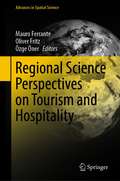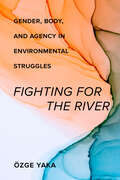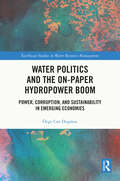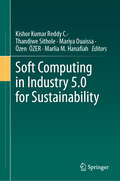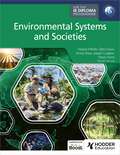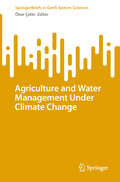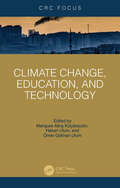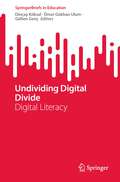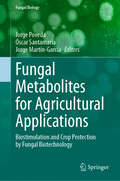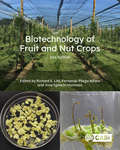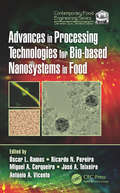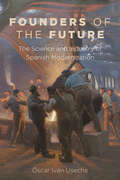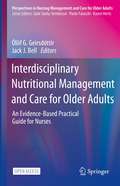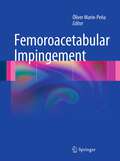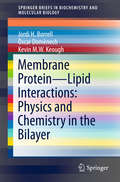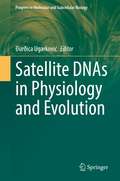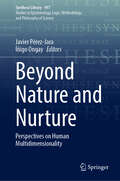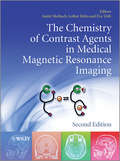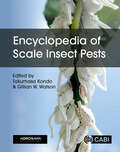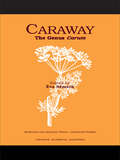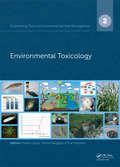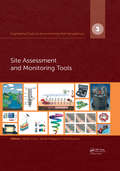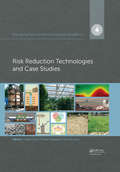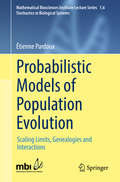- Table View
- List View
Regional Science Perspectives on Tourism and Hospitality (Advances in Spatial Science)
by Mauro Ferrante Oliver Fritz Özge ÖnerThis book approaches the tourism and hospitality industry from a regional science perspective. By analyzing the spatial context of tourist travels, the hospitality sector, and the regional impacts of tourist activities, it demonstrates the value of the regional science paradigm for understanding the dynamics and effects of tourism and hospitality-related phenomena. Written by leading regional science scholars from various countries as well as professionals from organizations such as OECD and AirBnB, the contributions address topics such as migration, new types of accommodation, segmentation of tourism demand, and the potential use of tracking technologies in tourism research.The content is divided into five parts, the first of which analyzes spatial effects on the development of firms in the tourism industry, while the second approaches temporal and spatial variability in tourism through analytical regional science tools. The broader economic and social impacts of tourism are addressed in part three. Part four assesses specific tourism segments and tourist behaviors, while part five discusses environmental aspects and tourism destination policies. The book will appeal to scholars of regional and spatial science and tourism, as well as tourism specialists and policymakers interested in developing science and evidence-based tourism policies.
Fighting for the River: Gender, Body, and Agency in Environmental Struggles
by Özge YakaFighting for the River portrays women's intimate, embodied relationships with river waters and explores how those relationships embolden local communities' resistance to private run-of-the-river hydroelectric power plants in Turkey. Building on extensive ethnographic research, Özge Yaka develops a body-centered, phenomenological approach to women's environmental activism and combines it with a relational ontological perspective. In this way, the book pushes beyond the "natural resources" frame to demonstrate how our corporeal connection to nonhuman entities is constitutive of our more-than-human lifeworld. Fighting for the River takes the human body as a starting point to explore the connection between lived experience and nonhuman environments, treating bodily senses and affects as the media of more-than-human connectivity and political agency. Analyzing local environmental struggles as struggles for coexistence, Yaka frames human-nonhuman relationality as a matter of socio-ecological justice.
Water Politics and the On-Paper Hydropower Boom: Power, Corruption, and Sustainability in Emerging Economies (Earthscan Studies in Water Resource Management)
by Özge Can DogmusThis book examines how the on-paper hydropower boom impacts the safe and fair access to water and energy in emerging economies.The global hydropower boom is largely made up of small hydropower plants located in emerging economies, but a lack of funding, over-ambitious planning, and corruption have halted the production of these projects. Describing this state as the ‘on-paper’ hydropower boom, this book shifts attention to the hydrosocial problems arising from hydropower projects that remain on paper. It examines how these proposed but unbuilt projects can lead to disruptions in the control and governance of water resources and increase the international dependence of emerging countries due to deep problems in their sustainable development planning and how all this can affect both ecosystems and the communities that depend on them. In doing so, it critically examines the dominant discourses on energy security and sustainable development, emphasises the extent to which the effects of global imperialism are at play, and examines the effects of international power relations in the hydrosocial context and their implications for perpetuating international relations of dependency. Further, this book provides a unique perspective on the global hydropower boom by highlighting that although the global hydropower boom largely remains on paper, it can still have a significant impact on human–water systems. Contributing to the debate on hydrosocial relationships, each chapter offers an insightful examination of the social, cultural, and political interactions that humans have with water and uses these insights to provide a nuanced understanding of the challenges and issues associated with on-paper plans.This book will be of great interest to students and scholars of water politics, water governance, political ecology, corruption and environmental economics, as well as sustainable development policymakers.
Soft Computing in Industry 5.0 for Sustainability
by Mariya Ouaissa Kishor Kumar Reddy C. Thandiwe Sithole Özen Özer Marlia M. HanafiahSoft computing and Industry 5.0 are two distinct concepts that, when combined, can have a significant impact on sustainability initiatives within various industries. Soft computing is a subfield of artificial intelligence (AI) that aims to address problems characterized by uncertainty, imprecision, and partial truth. It encompasses various computational techniques, such as fuzzy logic, neural networks, genetic algorithms, and machine learning, which enable machines to deal with complex and uncertain data in a more human-like manner. Soft computing techniques are particularly valuable in sustainability efforts because they can handle non-linear relationships and uncertain data that often arise in environmental and social contexts. For example, they can be used to optimize energy consumption, waste management, and resource allocation in industries by considering various factors and trade-offs. The book highlights the latest innovations in intelligent systems in classical machine learning, deep learning, Internet of Things (IoT), Industrial Internet of Things (IIoT), blockchain, knowledge representation, knowledge management, big data, and natural language processing. (NLP). The book contains many contemporary articles from both scientists and practitioners working in many fields where soft computing, intelligent systems and the IIoT can break new ground. Intelligent systems and the Internet of Things are now essential technologies in almost every field. From agriculture to industry to healthcare, the scope of smart systems and IIoT is as wide as the horizon. Nowadays, these technologies are extensively used in developed countries, but they are still at an early stage in emerging countries. The primary market of this book is senior undergraduate students, post graduate students, practitioners, researchers, academicians, industrialists, and professionals working in areas of core computer science, electrical engineering, mechanical engineering, environmental engineering and agricultural engineering. The secondary audience of this book is individuals working in the areas of manufacturing, agriculture, remote sensing, environmental engineering, health care, smart cities, smart farming, remote sensing, supply chain management and hydrology.
Environmental Systems and Societies for the IB Diploma (For the IB Diploma)
by Virginia D'Britto Öykü Dulun Emma Shaw Joseph CazabonDeveloped in cooperation with the International Baccalaureate® Ensure full coverage of the updated syllabus with a coursebook that implements inquiry-based and conceptually-focused teaching and learning, written by highly experienced global authors. - Explore the three key concepts in the new course: perspectives, systems and sustainability which allow students to deepen their understanding and make interdisciplinary connections throughout, with HL content clearly signposted. - Prepare students for assessment with a range of options: exam-style questions, top tip boxes and hints to help avoid common mistakes. - Integrate TOK into lessons and create opportunities for cross-curriculum study with case studies, real world examples and up-to-date data. - Provide plenty of practise with activities, review questions and chapter summaries allowing students to recap themes and test knowledge. - Enable students to feel confident in course terminology with ESL support, definitions, key terms and a glossary.
Environmental Systems and Societies for the IB Diploma (For the IB Diploma)
by Virginia D'Britto Öykü Dulun Emma Shaw Joseph CazabonDeveloped in cooperation with the International Baccalaureate® Ensure full coverage of the updated syllabus with a coursebook that implements inquiry-based and conceptually-focused teaching and learning, written by highly experienced global authors. - Explore the three key concepts in the new course: perspectives, systems and sustainability which allow students to deepen their understanding and make interdisciplinary connections throughout, with HL content clearly signposted. - Prepare students for assessment with a range of options: exam-style questions, top tip boxes and hints to help avoid common mistakes. - Integrate TOK into lessons and create opportunities for cross-curriculum study with case studies, real world examples and up-to-date data. - Provide plenty of practise with activities, review questions and chapter summaries allowing students to recap themes and test knowledge. - Enable students to feel confident in course terminology with ESL support, definitions, key terms and a glossary.
Agriculture and Water Management Under Climate Change (SpringerBriefs in Earth System Sciences)
by Öner ÇetinThis book analyzes how major events such as the recent pandemic crisis, wars around the world and climate change, have affected agricultural production and the direct food supply. In this sense, human nutrition will never be off the agenda. The book provides information and guidelines for both practitioners and decision-makers about important developments in the use of agriculture, soil and water resources for agricultural purposes, including the effective and efficient use of soil and water resources where agricultural production, increasing water productivity, the use of modern technology and digitalization for this purpose. Accordingly, a number of chapters have been prepared by experts in the field, covering a variety of the above-mentioned objectives.
Climate Change, Education, and Technology
by Ömer Gökhan Ulum Hakan Ulum Menşure Alkış KüçükaydınThe climate change crisis is the greatest challenge humanity has ever confronted. As human activities are the most significant cause for this crisis, the solution must come from within humanity. While global movements—NGOs, universities, municipal governments, etc.—are doing their part to combat the crisis, the role of education and technology cannot be emphasized enough. Education is necessary to enhance awareness, especially among the youth, generate solutions, and implement them. Technology contributes to this process by creating climate change-fighting solutions, accumulating and analysing data, and providing energy efficiency. Technology also enables the monitoring of the climate, the mitigation of its effects, and the enhancement of the environment. Therefore, climate change, education, and the use of technology should be addressed as a unit. In this volume, the authors integrate climate change, education, and technological applications.This book is comprehensive and offers readers a variety of perspectives, encouraging the generation of novel and inventive ideas. The collaboration of authors from various disciplines to address the issue brings about novel and intriguing perspectives.
Undividing Digital Divide: Digital Literacy (SpringerBriefs in Education)
by Ömer Gökhan Ulum Dinçay Köksal Gülten GençThis book problematizes digital divide with critical lens by focusing on education in general and specifically second language education with an emphasis on the context of Turkey based on sound methodologies and robust theories of modernity, postmodernity, post-structuralism and post-method framework. In line with this conceptualization, critical thinking skills, social dialogue, collaboration, accessibility and digital literacy have been widely discussed empirically and prioritized in this book. In addition, social injustice, digital inequality, gender gap, economic disparity, demographic differences and knowledge divide have also been addressed. EFL teachers and pre-service teachers as cultural workers have been incorporated into the studies to critically reflect upon digital divide in Turkey. The views of teachers and learners at a socio-economic disadvantage emanating from socio-political issues have been addressed and foregrounded. The digital divide and inequalities that COVID-19 pandemic has produced have also been emphasized. The context of Turkey where digital divide has been prevalent during COVID-19 pandemic is believed to inspire researchers specializing in digitalization and digital education. The strategies, problems, effects and solutions have been presented. This book presents a reliable source to students, teachers and academics in education and second language education as well as social scientists and policy-makers across the globe.
Fungal Metabolites for Agricultural Applications: Biostimulation and Crop Protection by Fungal Biotechnology (Fungal Biology)
by Jorge Poveda Óscar Santamaría Jorge Martín-GarcíaThis book delves into the fascinating world of fungal metabolites and their biotechnological potential for sustainable agriculture. Through this book, readers will learn about the production and characterization of metabolites by endophytic and rhizospheric fungi, including filamentous fungi like Trichoderma, Penicillium, and Aspergillus, as well as mycorrhizal fungi and yeasts. The chapters cover topics such as the promotion of plant growth, increased tolerance to abiotic stresses, and biological control through the application of fungal metabolites. Expert contributors provide an in-depth analysis of how these metabolites can be produced in bioreactors or applied directly as agricultural bioinoculants. Particular attention is given to the environmental and health benefits of using fungal metabolites in crop improvement. Researchers in the field of agricultural biotechnology, plant sciences, and environmental sustainability will find this book invaluable. It offers a comprehensive discussion from biological, chemical, and applied perspectives, making it a must-read for anyone interested in advancing sustainable agriculture practices.
Biotechnology of Fruit and Nut Crops
by Maria Luisa Badenes Patrick Brown Nicolas Roux Araceli Barceló-Muñoz Vicente Vicente Óscar Martínez Eddo Rugini Luciana Baldoni Alain Rival Magda-Viola Hanke Henryk Flachowsky Julie Graham Luis A. Cañas Dennis J. Gray Stephen Adkins J. R. Botella Leandro Pena Ossama Kodad Pedro Martínez-Gómez Abhaya Dandekar Sadanand A. Dhekney Yuval Cohen Kate Evans Nuria Alburquerque Pedro M. Barros A. T. Basford Muhammad Ajmal Bashir Diego Silva Batista Dr Julianne Biddle Manuel Blasco Lorenzo Burgos John E. Carlson Elisabeth Carmona David Chagné Rekha Chaudhury Elisabeth Chevreau V. E. Chhatre Yelda Özden Çiftçi C. Claflin Elena Corredoira Valerio Cristofori Niccolò Cultrera Maurecilne Lemes da Silva Leo D’Souza Ofere Francis Emeriewen M. Faize Fábio Gelape Faleiro Ana Paula Farinha Yolanda Ferradás Antonio Figueira Maureen M.M. Fitch M. Foale Svetlana Y. Folimonova María Victoria González Isabel María González-Padilla Smitha Hegde Professor Jose Ignacio Hormaza Uma Jaiswal Nikki Jennings Hülya Akdemir Koç Nerea Larrañaga Chuck Leslie Z. J. Li Amanda De Lopes Carlos López-Encina Rodolfo López-Gómez Jorge Lora Zheng-Rong Luo S. K. Malik Roberto Mariotti Antonio J. Matas José Mercado Scott Merkle Sara Montanari Gloria Moore Soraya Mousavi Isabel Narváez María Del Naval Q. T. Nguyen Shashikiran Nivas M. Margarida Oliveira Ahmet Onay Guillermo Padilla Elena Palomo-Ríos Andreas Peil Rosa M. Pérez-Clemente Cesar Petri Paula M. Pijut Marcos Vinícius Pinheiro Clara Pliego Fernando Pliego-Alfaro Simon H.T. Raharjo Manoj K Rai Manuel Rey Gabino Ríos Diego Ismael Rocha M. B. Rosenberg M. Rouard D. Ruiz J. Sardos Danielle Camargo Scotton Cristian Silvestri Michael K Smith Guo-Qing Song Veysel Süzerer Alicia Talavera Ryutaro Tao Takuya Tetsumura Engin Tilkat Pablo Ric Varas Wagner Vendrame Francisco Javier Viéitez Hazel Wetzstein Roxana Yockteng Qing-Lin ZhangThis book covers the biotechnology of all the major perennial fruit and nut species. Since the publication of the first edition of this book in 2005, there has been significant progress in cell culture, genomics and genetic transformation for many of these species. This book covers these biotechnologies and also traditional ones, such as regeneration pathways, protoplast culture, in vitro mutagenesis, and ploidy manipulation that have been applied to many of these species. Three species, Diospyros kaki (persimmon), Punica granatum (pomegranate) and Eriobotrya japonica (loquat) are included for the first time, and several Prunus species now receive separate coverage. The species are organized by plant family to facilitate comparisons among related ones. Each species is discussed in relation to its family and its related wild forms, and most are accompanied by full colour illustrations. This book is a vital resource for those working on the improvement of perennial fruit, nut and plantation crops. The book features: Detailed coverage of major perennial fruit and crop species. Coverage of traditional and new biotechnologies. Full colour illustrations to aid identification This book is an essential resource for scientists and postgraduate students who are engaged in the improvement of perennial fruit, nut and plantation crops and will also be an important accession for university and agricultural research libraries.
Advances in Processing Technologies for Bio-based Nanosystems in Food (Contemporary Food Engineering #1)
by António A. Vicente Óscar L. Ramos Ricardo N. Pereira Miguel A. Cerqueira José A. TeixeiraNanotechnology can be used to address challenges faced by the food and bioprocessing industries for developing and implementing improved or novel systems that can produce safer, nutritious, healthier, sustainable, and environmental-friendly food products. This book overviews the most recent advances made on the field of nanoscience and nanotechnology that significantly influenced the food industry. Advances in Processing Technologies for Bio-Based Nanosystems in Food provides a multidisciplinary review of the complex mechanisms involved in the research, development, production and legislation of food containing nanostructures systems. Features: Presents the most recent advances made in the field of nanoscience and nanotechnology as applied to the food industry Discusses innovative approaches and processing technologies Shows how nanotechnology can be used to produce safer, nutritious, healthier, sustainable and environmental-friendly food products Covers the complex mechanisms involved in the research, development, production and legislation of food containing nanostructures Selected examples of nanotechnology applications in food industry are shown, focusing on advanced aspects of food packaging, processing and preservation; followed by one contribution that presents the potential commercialization and the main challenges for scale-up. Comprised of 15 chapters, this book provides much-needed and up-to-date information on the use of emergent technologies in bio-based nanosystems for foods, and serves as an ideal reference for scientists, regulators, industrialists, and consumers that conduct research and development in the food processing industry.
Founders of the Future: The Science and Industry of Spanish Modernization (Campos Ibéricos: Bucknell Studies in Iberian Literatures and Cultures)
by Óscar Iván UsecheIn this ambitious new interdisciplinary study, Useche proposes the metaphor of the social foundry to parse how industrialization informed and shaped cultural and national discourses in late nineteenth- and early twentieth-century Spain. Across a variety of texts, Spanish writers, scientists, educators, and politicians appropriated the new economies of industrial production—particularly its emphasis on the human capacity to transform reality through energy and work—to produce new conceptual frameworks that changed their vision of the future. These influences soon appeared in plans to enhance the nation’s productivity, justify systems of class stratification and labor exploitation, or suggest state organizational improvements. This fresh look at canonical writers such as Emilia Pardo Bazán, Concha Espina, Benito Pérez Galdós, Vicente Blasco Ibáñez, and José Echegaray as well as lesser known authors offers close readings of their work as it reflected the complexity of Spain’s process of modernization.
Interdisciplinary Nutritional Management and Care for Older Adults: An Evidence-Based Practical Guide for Nurses (Perspectives in Nursing Management and Care for Older Adults)
by Ólöf G. Geirsdóttir Jack J. BellThis open access book aims to primarily support nurses as leaders and champions of multimodal, Interdisciplinary nutrition care for older adults. A structured approach to fundamentals of nutrition care across Interdisciplinary settings is combined with additional short chapters about special topics in geriatric nutrition. The book is designed to provide highly accessible information on evidence-based management and care for older adults, with a focus on practical guidance and advice across acute, rehabilitation, and primary and secondary malnutrition prevention settings.The cost of malnutrition in England alone has been estimated to be £19.6 billion per year, or more than 15% of the total public expenditure on health and social care. ^65 years. The importance and benefit of specialised nutrition care, delivered by experts in field, is well established for those with complex nutrition care needs. However, despite the substantial adverse impact of malnutrition on patient and healthcare outcomes, specialised management of this condition is often under-resourced, overlooked and under-prioritised by both older adults and their treating teams. As an alternative, timely, efficient, and effective supportive nutrition care opportunities may be appropriately implemented by nurses and non-specialist Interdisciplinary healthcare team members, working together with nutrition specialists and the older adults they care for. Practical, low-risk opportunities should be considered across nutrition screening, assessment, intervention, and monitoring domains for many patients with, or at risk of malnutrition. Whilst a variety of team members may contribute to supportive nutrition care, the nursing profession provide a clear focal point. Nurses across diverse settings provide the backbone for Interdisciplinary teamwork and essential patient care. The nursing profession should consequently be considered best placed to administer Interdisciplinary, multimodal nutrition care, wherever specialist nutrition care referrals are unlikely to add value or are simply not available. As such, the book is a valuable resource for all healthcare providers dedicated to working with older patients to improve nutrition care.
Femoroacetabular Impingement
by Óliver Marín-PeñaThis book is the first monograph to examine all aspects of femoroacetabular impingement (FAI), an important disease first described early in the twenty-first century. Comprising 27 chapters and including many color illustrations, the book contains a variety of points of view from more than 50 experts from 11 countries and represents an up-to-date compilation of professional knowledge on FAI. The full range of available surgical treatments is carefully described and evaluated, including arthroscopic treatment, the open and mini-open approaches, periacetabular osteotomy, hip resurfacing arthroplasty, and combined techniques. Differential diagnosis, imaging, postoperative management, and treatment outcome are also discussed in appropriate detail. It is hoped that this book will promote a comprehensive approach to what is a common pathology and thereby encourage further improvement in treatment.
Membrane Protein - Lipid Interactions: Physics and Chemistry in the Bilayer
by Jordi H. Borrell Òscar Domènech Kevin M. W. KeoughThis book has been conceives as a brief introduction to biomembranes physical chemistry for undergraduate students of sciences, and it is particularly dedicated to the lipid-protein membrane interactions. A general introduction is presented in Chapters 1 and 2. The following Chapters, 3 and 4, describe the most accepted theories on lipid-membrane protein interactions as well as the new experimental approaches, in particular, these arose from nano sciences as atomic for microscopy and single molecule force spectroscopy. The book emphasizes the relevance of physical parameters as the lateral surface pressure and the lipid curvature as actors for understanding the physicochemical properties of the biomembranes.
Satellite DNAs in Physiology and Evolution (Progress in Molecular and Subcellular Biology #60)
by Ðurðica UgarkovićThis book gives a comprehensive overview of the unique roles that non-coding repetitive elements such as satellite DNAs play in different physiological and evolutionary processes. It presents the gene-regulatory aspect of satellite DNAs in different model systems including mammals, insects and plants. In addition, evolutionary aspects of activation of satellite DNAs in terms of transcription and proliferation are highlighted, revealing the role of satellite DNAs in the process of adaptation to changing environment and in the speciation process.Finally, the book discusses satellite DNA activation during pathological transformation and the mechanisms by which they affect disease progression. Namely, some satellite DNAs promote the oncogenic processes by affecting genome epigenetic regulation as well as genome integrity. Readers get a full overview of the latest research on satellite DNA.
Beyond Nature and Nurture: Perspectives on Human Multidimensionality (Synthese Library #497)
by Javier Pérez-Jara Íñigo OngayThis book gathers several of the world&’s leading scholars in the nature vs. nurture debate, offering a timely reconsideration of the dynamic interactions between physical, chemical, biological, social, and cultural factors that shape human multidimensionality. Emphasizing this multidimensionality, this edited volume seeks to bridge the divide between biology and social theory—two research communities that have too often overlooked each other. These disciplines, despite being central to understanding human nature, have long operated in isolation. While some animal species exhibit higher degrees of phenotypic plasticity in specific traits, humans stand out as the most plastic species in both their neurological and sociocultural systems. This plasticity leads the contributors of this book to move beyond both biological reductionism and the blank-slate hypothesis. While biology undoubtedly plays a role in shaping and stabilizing human social and cultural processes, it does so only within the framework of an inherently social environment—one shaped by historically contingent and socially constructed realities, such as values, codes, and cultural perceptions. More importantly, cultural structures and social interactions actively shape and transform certain biological features that were once considered immutable. This book lays the groundwork for a productive dialogue among biologists, psychologists, social theorists, and philosophers. It also highlights some of the moral and political consequences of different perspectives within the nature vs. nurture debate. Through updated scientific and philosophical theorizing, the chapters in this book aim to overcome, once and for all, the simplistic yet persistent opposition between nature and nurture, offering a far more complex and dynamic—yet richer and epistemologically manageable—picture of the human being.
The Chemistry of Contrast Agents in Medical Magnetic Resonance Imaging
by Lothar Helm Éva Tóth Andre S. MerbachMagnetic Resonance Imaging (MRI) is one of the most important tools in clinical diagnostics and biomedical research. The number of MRI scanners operating around the world is estimated to be approximately 20,000, and the development of contrast agents, currently used in about a third of the 50 million clinical MRI examinations performed every year, has largely contributed to this significant achievement.This completely revised and extended second edition: Includes new chapters on targeted, responsive, PARACEST and nanoparticle MRI contrast agents.Covers the basic chemistries, MR physics and the most important techniques used by chemists in the characterization of MRI agents from every angle from synthesis to safety considerations.Is written for all of those involved in the development and application of contrast agents in MRI.Presented in colour, it provides readers with true representation and easy interpretation of the images. A word from the Authors:Twelve years after the first edition published, we are convinced that the chemistry of MRI agents has a bright future. By assembling all important information on the design principles and functioning of magnetic resonance imaging probes, this book intends to be a useful tool for both experts and newcomers in the field. We hope that it helps inspire further work in order to create more efficient and specific imaging probes that will allow materializing the dream of seeing even deeper and better inside the living organisms.Reviews of the First Edition:"...attempts, for the first time, to review the whole spectrum of involved chemical disciplines in this technique..."--Journal of the American Chemical Society"...well balanced in its scope and attention to detail...a valuable addition to the library of MR scientists..."--NMR in Biomedicine
Encyclopedia of Scale Insect Pests
by Helen Harman Jan H. Giliomee Jocelyn A. Berry Manuela Branco Lyle Buss Mr Alejandro Caballero Mr Juang Horng Chong Lucía E. Claps C. De Klerk Rodrigo Diaz Imre Foldi Antonio P. Garonna Ilya A. Gavrilov-Zimin Raymond J. Gill Penny J. Gullan Disna N. Gunawardana Sunil Joshi M. Bora Kaydan Paris L. Lambdin Yen-Po Lin Christopher Malumphy Zvi Mendel Vitor Cezar Pacheco da Silva Giuseppina Pellizzari Ana Lúcia Peronti Francesco Porcelli Alex Protasov Ting-Kui Qin Andrea Amalia Ramos Portilla Dewi Sartiami Scott A. Schneider U.G.A.I. Sirisena Pompeo Suma Éva Szita Hirotaka TanakaScale insects feed on plant juices and can easily be transported to new countries on live plants. They sometimes become invasive pests, costing billions of dollars in damage to crops worldwide annually, and farmers try to control them with toxic pesticides, risking environmental damage. Fortunately, scale insects are highly susceptible to control by natural enemies so biological control is possible. They have unique genetic systems, unusual metamorphosis, a broad spectrum of essential symbionts, and some are sources of commercial products like red dyes, shellac and wax. There is, therefore, wide interest in these unusual, destructive, beneficial, and abundant insects. The Encyclopedia of Scale Insect Pests is the most comprehensive work on worldwide scale insect pests, providing detailed coverage of the most important species (230 species in 26 families, 36% of the scale insect pest species known). Advice is provided on collection, preservation, slide-mounting, vouchering, and labelling of specimens, fully illustrated with colour photographs, diagrams and drawings. Pest species are presented in two informal groups of families, the 'primitive' Archaeococcoids followed by the more 'advanced' Neococcoids, covered in phylogenetic order. Each family is illustrated and diagnosed based on features of live and slide-mounted specimens, with information on numbers of genera and species, main hosts, distribution, and biology. For the important pest species, coverage includes information on the morphology of live and slide-mounted specimens, common names, principal synonyms, geographical distribution, plant hosts, plant damage and economic impact, reproductive biology, dispersal, and management strategies including biological, cultural and chemical control, sterile insect techniques, regulatory control, early warning systems and field monitoring. An additional complete list of scale insect pests worldwide is provided, comprising 642 species in 28 scale insect families (about 8% of the 8373 species of living scales known), with information on plant hosts, geographical distribution and validation sources. Beneficial uses of scale insects include sources of red dyes, natural resins and waxes, and agents for invasive weed control, alongside the importance of their honeydew to bees for making honey, and as a food source to other animals. Academic researchers, students, entomologists, pest management officials in agribusiness or government including plant quarantine identifiers, extensionists, farmers, field scientists and ecologists will all benefit from this book.
Caraway: The Genus Carum
by Éva NémethCaraway, the seventh volume in the series Medicinal and Aromatic Plants - Industrial Profiles, collects together all of the existing information in connection with the biology, chemistry, agrotechnology and utilization of the plant genus Carum. After an overview on all Carum species, it deals mainly with th most important species Carum carvi L. The
Engineering Tools for Environmental Risk Management: 2. Environmental Toxicology (Engineering Tools for Environmental Risk Management)
by Katalin Gruiz Tamás Meggyes Éva FenyvesiChemical substances, physical agents and built structures exhibit various types of hazard due to their inherent toxic, mutagenic, carcinogenic, reprotoxic and sensitizing character or damaging to the immune and hormone system. The first steps in managing an environment contaminated by chemical substances are characterization of hazards and quantifi
Engineering Tools for Environmental Risk Management: 3. Site Assessment and Monitoring Tools (Engineering Tools for Environmental Risk Management #3)
by Katalin Gruiz Éva Fenyvesi TamásThis is the third volume of the five-volume book series “Engineering Tools for Environmental Risk Management”. The book series deals with the following topics: • Environmental deterioration and pollution, management of environmental problems• Environmental toxicology – a tool for managing chemical substances and contaminated environment• Assessment and monitoring tools, risk assessment• Risk reduction measures and technologies• Case studies for demonstration of the application of engineering tools The authors aim to describe interactions and options in risk management by providing a broad scientific overview of the environment, its human uses and the associated local, regional and global environmental problems; interpreting the holistic approach used in solving environmental protection issues; striking a balance between nature’s needs and engineering capabilities; understanding interactions between regulation, management and engineering; obtaining information about novel technologies and innovative engineering tools. This third volume provides an overview on the basic principles, concepts, practices and tools of environmental monitoring and contaminated site assessment. The volume focuses on those engineering tools that enable integrated site assessment and decision making and ensure an efficient control of the environment. Some topics supporting sustainable land use and efficient environmental management are listed below: • Efficient management and regulation of contaminated land and the environment;• Early warning and environmental monitoring;• Assessment of contaminated land: the best practices;• Environmental sampling;• Risk characterization and contaminated matrix assessment;• Integrated application of physical, chemical, biological, ecological and (eco) toxicological characterization methods;• Direct toxicity assessment (DTA) and decision making;• Online analyzers, electrodes and biosensors for assessment and monitoring of waters.;• In situ and real-time measurement tools for soil and contaminated sites;• Rapid on-site methods and contaminant and toxicity assessment kits;• Engineering tools from omics technologies, microsensors to heavy machinery;• Dynamic characterization of subsurface soil and groundwater using membrane interface probes, optical and X-ray fl uorescence and ELCAD wastewater characterization;• Geochemical modeling: methods and applications;• Environmental assessment using cyclodextrins. This book series focuses on the state of knowledge about the environment and its conscious and structured application in environmental engineering, management and decision making.
Engineering Tools for Environmental Risk Management: 4. Risk Reduction Technologies and Case Studies (Engineering Tools for Environmental Risk Management #4)
by Katalin Gruiz Tamás Meggyes Éva FenyvesiThe four volumes of the book series "Engineering Tools for Environmental Risk Management" deal with environmental management, assessment & monitoring tools, environmental toxicology and risk reduction technologies. This last volume focuses on engineering solutions usually needed for industrial contaminated sites, where nature’s self-remediation is inefficient or too slow. The success of remediation depends on the selection of an increasing number of conventional and innovative methods. This volume classifies the remedial technologies and describes the reactor approach to understand and manage in situ technologies similarly to reactor-based technologies. Technology types include physicochemical, biological or ecological solutions, where near-natural, sustainable remediation has priority. <P><P>A special chapter is devoted to natural attenuation, where natural changes can help achieve clean-up objectives. Natural attenuation and biological and ecological remediation establish a serial range of technologies from monitoring only to fully controlled interventions, using ‘ just’ the natural ecosystem or sophisticated artificial living systems. Passive artificial ecosystems and biodegradation-based remediation – in addition to natural attenuation – demonstrate the use of these ‘green’ technologies and how engineering intervention should be kept at a minimum to limit damage to the environment and create a harmonious ecosystem. <P><P>Remediation of sites contaminated with organic substances is analyzed in detail including biological and physicochemical methods. Comprehensive management of pollution by inorganic contaminants from the mining industry, leaching and bioleaching and acid mine drainage is studied in general and specifically in the case of an abandoned mine in Hungary where the innovative technology of combined chemical and phytostabilization has been applied. <P><P>The series of technologies is completed by electrochemical remediation and nanotechnologies. Monitoring, verification and sustainability analysis of remediation provide a comprehensive overview of the management aspect of environmental risk reduction by remediation. This book series focuses on the state of knowledge about the environment and its conscious and structured application in environmental engineering, management and decision making.
Probabilistic Models of Population Evolution
by Étienne PardouxThis expository book presents the mathematical description of evolutionary models of populations subject to interactions (e. g. competition) within the population. The author includes both models of finite populations, and limiting models as the size of the population tends to infinity. The size of the population is described as a random function of time and of the initial population (the ancestors at time 0). The genealogical tree of such a population is given. Most models imply that the population is bound to go extinct in finite time. It is explained when the interaction is strong enough so that the extinction time remains finite, when the ancestral population at time 0 goes to infinity. The material could be used for teaching stochastic processes, together with their applications. Étienne Pardoux is Professor at Aix-Marseille University, working in the field of Stochastic Analysis, stochastic partial differential equations, and probabilistic models in evolutionary biology and population genetics. He obtained his PhD in 1975 at University of Paris-Sud.
